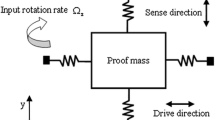Abstract
In this paper, the elec tromechanical modeling of a differential capacitive sensor interconnected with a floating-gate MOS (FGMOS) transistor is shown; the model was obtained using the Euler–Lagrange theory to analyze this particular physical system used as an inertial sensor. A design methodology is also shown relating all the physical parameters involved, such as: stiffness, damping associated with the capacitive structure, parasitic capacitances present in the transistor, and the maximum operating voltages to avoid pull-in effect. Cases for symmetric and non symmetric differential capacitance comb arrays are analyzed. A model comparison between conventional mass–spring–damper mechanical systems to a specific electromechanical system for capacitive sensor with its associated readout electronics is shown.







Similar content being viewed by others
References
Croci L, Martinez A, Coirault P, Champenois G, Gaubert J-P (2012) Passivity-based control of photovoltaic-wind hybrid system with Euler–Lagrange modeling. 38th Annual Conference on IEEE Industrial Electronics Society (IEEE)
Huei-Huang L (2012) Finite element simulations with ANSYS workbench 14, theory, applications, case studies. SDC
Mezghani B, Tounsi F, Masmoudi M (2013) Sensitivity modeling of dual-axis CMOS MEMS convective accelerometers using FEM and spherical model (©EDA Publishing)
Pustan M, Paquay S, Rochus V, Golinval J-C (2010) Modeling and finite element analysis of mechanical behavior of flexible MEMS components. DTIP (©EDA Publishing)
Su Y, Chong CS (2005) Automatic mixed-dimensional MEMS modeling. International Conference on Advanced Intelligent Mechatronics (IEEE/ASME), pp 24–28
Van Toan N, Ono T (2014) Capacitive silicon resonator structure with movable electrodes to reduce capacitive gap widths based on electrostatic parallel plate actuation. MEMS, San Francisco
Zeng K, Liu Z, Korvink JG (2003) A new methodology for modeling MEMS structures. Design, Test, Integration and Packaging of MEMSiMOEMS (DTIP)
Zeng Z, Yang H, Zhao R, Tang S, Chen LI (2011) An electromechanical coupling model for an inclined drum washing machine vibration system based on Euler–Lagrange theory. International Electric Machines and Drives Conference (IEMDC) (IEEE)
Zhang Z, Liu H (2007) L2-gain control for single-phase active power filter using Euler–Lagrange model. International Symposium on Industrial Electronics, ISIE (IEEE), pp 2469–2474
Zhao C, Wang L, Kazmierski TJ (2007) An efficient and accurate MEMS accelerometer model with sense finger dynamics for applications in mixed-technology control loops. IEEE pp 143–147
Acknowledgments
The authors wish to thank CONACyT Project number 124103 and the Micro and Nano Technology Laboratory from the CNMN-IPN for their support.
Author information
Authors and Affiliations
Corresponding author
Rights and permissions
About this article
Cite this article
Abarca-Jiménez, G.S., Reyes-Barranca, M.A., Mendoza-Acevedo, S. et al. Electromechanical modeling and simulation by the Euler–Lagrange method of a MEMS inertial sensor using a FGMOS as a transducer. Microsyst Technol 22, 767–775 (2016). https://doi.org/10.1007/s00542-015-2429-3
Received:
Accepted:
Published:
Issue Date:
DOI: https://doi.org/10.1007/s00542-015-2429-3




